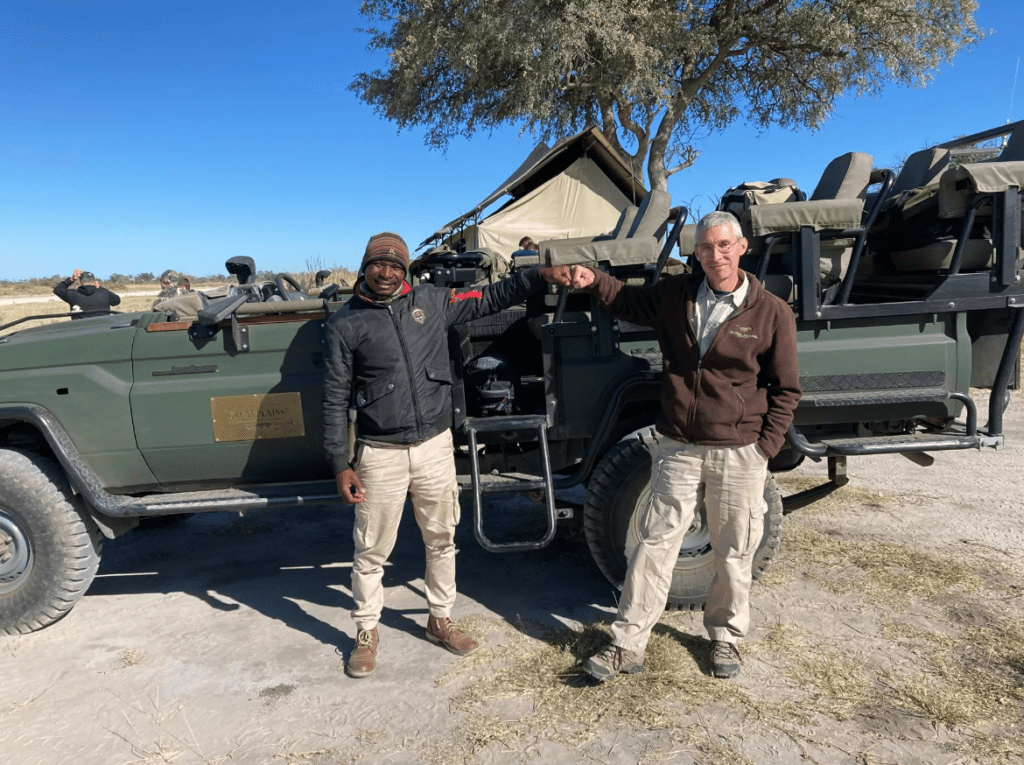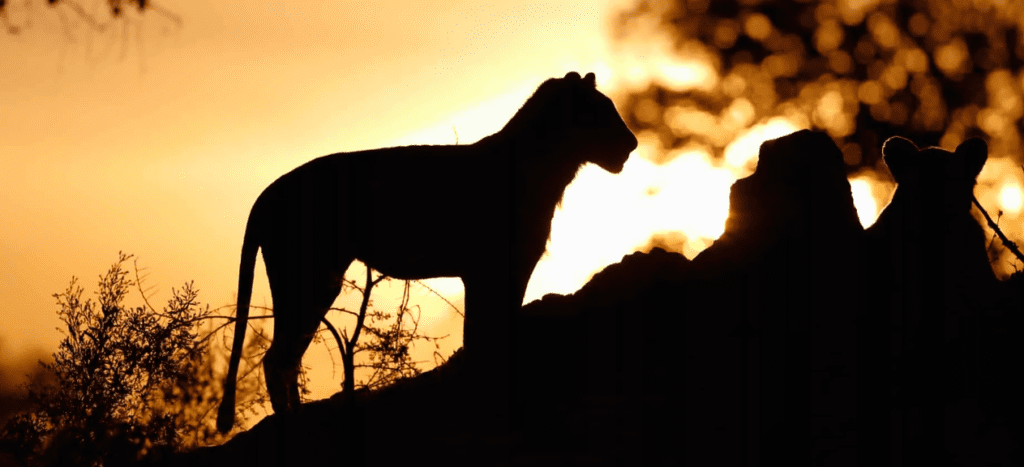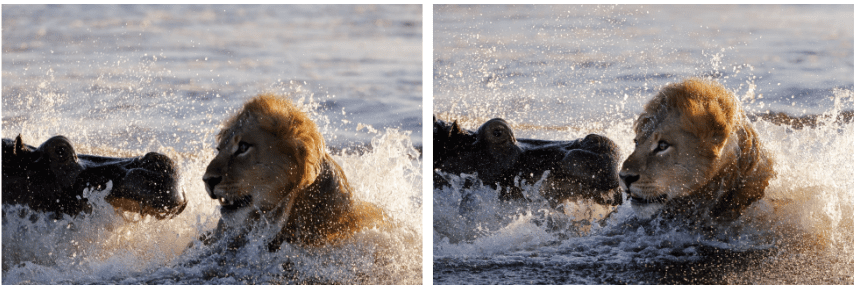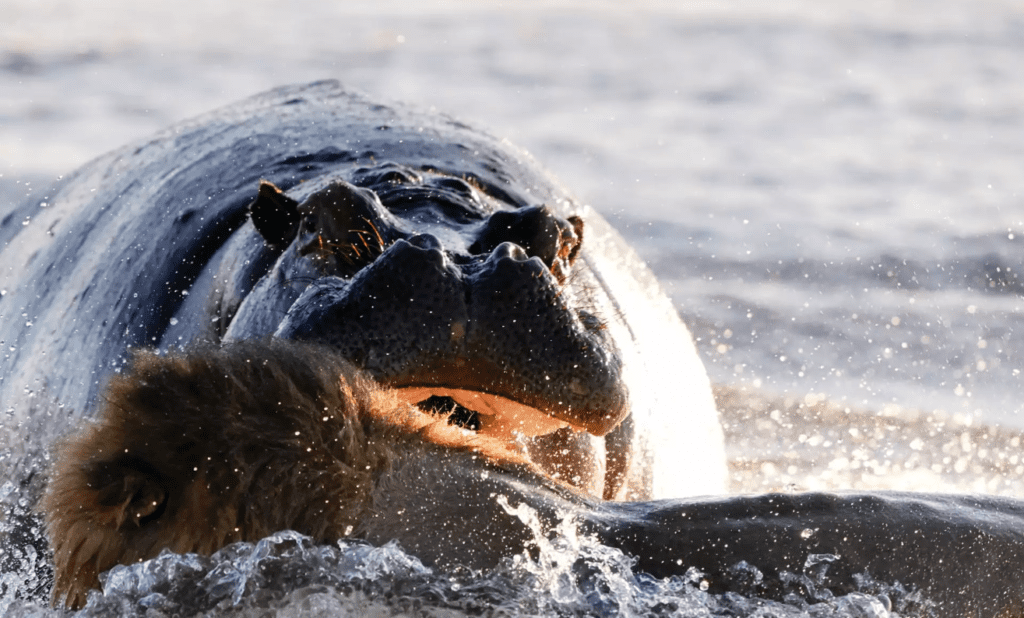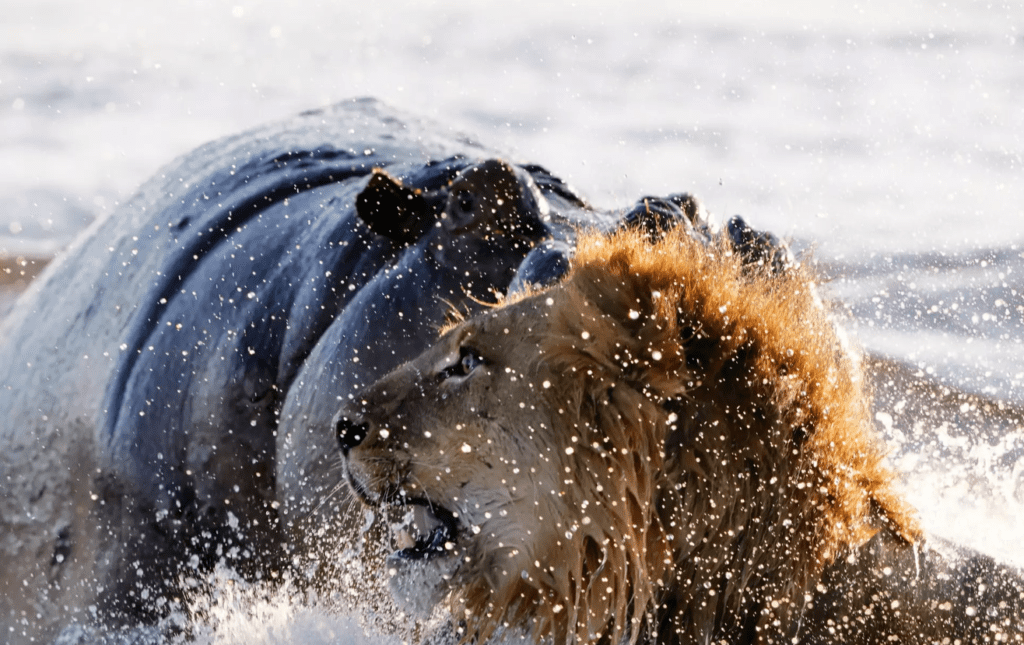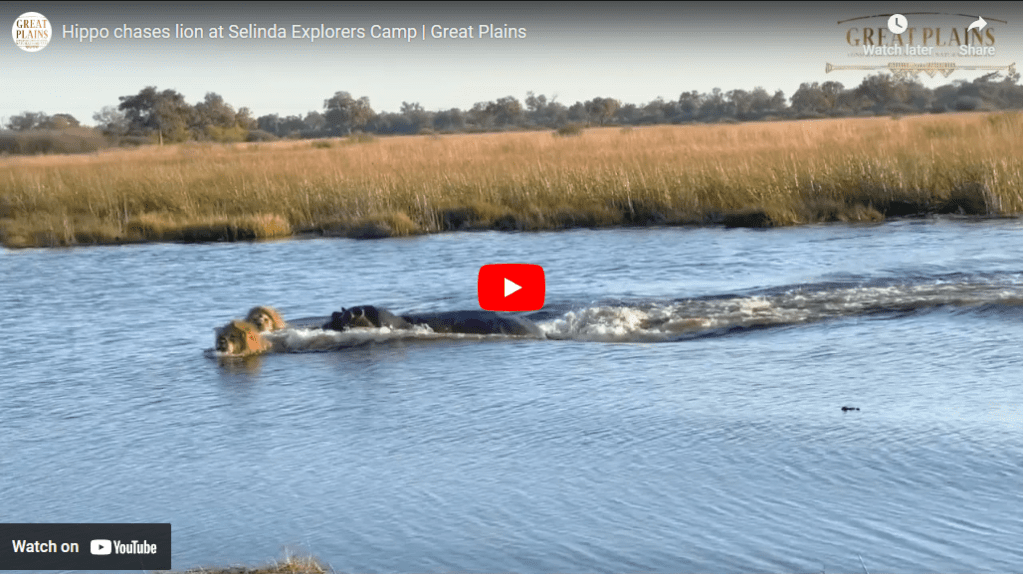Great Plains Conservation – Safari Sightings Botswana
Lions versus Hippo – a Clash of The Titans by Chris Swindal
AAC numerous times past client Chris Swindal was able to witness lions swimming across one of the Selinda Spillway channels- a safari guest’s dream! To then see and capture the event of a territorial hippo chasing those lions is a spectacle that is truly a rare occurrence!
Thank you, Chris Swindal for sharing the below words and imagery with us as well as allowing us to share this with you today.
Selinda Reserve, Botswana
Selinda is a remote area in the far north of Botswana and is one of the least visited and most pristine corners of the country. It comprises 1,350 square kilometres in the Linyanti region and lies between the Okavango to the Northwest and Savuti and Chobe National Park to the East. A river channel known as the Selinda Spillway winds through Selinda, flowing from the Okavango Delta into the Zibidianja Lagoon before splitting into the Linyanti and Chobe rivers to feed to the Savute Channel.
Selinda Spillway from the air, June 9, 2022, with currently low water conditions.
Selinda Camp is situated directly on the Selinda Spillway close to the Namibian border, close to Zibidianja Lagoon. There are only three camps in the entire region with a combined total of only 11 tents. It is rare to come across another safari vehicle here, so you are almost always on your own, which makes tracking extremely fun and very rewarding, as will become evident.
The map that is posted at the Selinda airstrip shows the main features of the private Selinda Reserve and the locations of the three camps.
Prior to 2004, Selinda was a hunting concession. To say that many of the hunting activities were irresponsible would be an understatement; some of them were unspeakably cruel in the extreme. These activities were documented in detail over 15 years by Dereck Joubert, well-known for his many National Geographic films, wildlife documentaries, and conservation efforts. Many of the species in the area were driven to the brink of collapse, including iconic “trophy” species such as lions.
In 2004, Dereck and Beverly Joubert acquired the government lease for the Selinda Concession and transformed it from a hunting concession into a wildlife preserve. The Jouberts recently produced the National Geographic film, “Birth of a Pride”, which documents the first two male lions to venture back into Selinda from Namibia after the guns fell silent to join the last two lionesses who wandered their decimated area, calling into a void left by the hunters.
“Africa… Botswana… over a century of hunting has left some areas silent. A lone lioness and her grown daughter are the last remnants of a pride that once roamed here. By the mid-2000s, this paradise could have been lost in the mists of time, a footnote in the tales of places where the big cats once ruled. But then… two things happened. Hunting in this remote area stopped… and impossibly, two male lions arrived… from nowhere. These mysterious lions have been waiting years for the gunshots to stop. At last, they respond to the silence beyond the river and start a series of forays into the female’s land. Today is their day, and this is the moment of hope for the lions in this paradise.”
June 6-8, 2022 | Selinda, Botswana
That moment of hope has become quite the success. The increase of the lion population in the Selinda region has been remarkable, thanks in large part to the conservation efforts led by Dereck and Beverly Joubert. As of June 6, 2022, there is a coalition of six lion brothers in Selinda… *six*!!! Di Tau tse nne. This stunning and fearsome group of boys in their prime rules and protects not one but two separate super prides in the area; the Selinda Pride and the Wapoke Pride (Wapoke means crazy in Setswana). Very few lions prides reach super pride status, which is defined as 15 members or more. This is because such large prides require huge amounts of food and need to kill all the time to feed all of those mouths, often leading to conflict between pride members, which then results in the pride splintering into multiple smaller prides. As of this writing, the Selinda Pride is 26 strong, including the 6 males, while the Wapoke Pride is 20+ strong, not including the males. The ‘plus’ is for additional newly born cubs, the number of which has not yet been determined. The six ruling brothers, Di Tau tse nne, move back and forth freely between the two super prides and their territories, and together are so strong that they have so far successfully repelled all challengers to both prides.
On June 6, we spot a lioness in the distance. She was keeping an eye on us long before we spotted her.
Nearby a sub-adult has also been keeping an eye on us, stares at us and gets up as we make our way toward the lioness in the distance.
Another one peers out from behind a tree.
As we get closer to the lioness we first spotted, a second lion joins her on the mound.
Then two more walk up from the backside of the mound to join them, making it four.
And then the other two join, making it six gathered together. These are two lioness sisters with their four sub-adult cubs. This already looks like an imposing bunch. They are part of the Wapoke pride, run by Di Tau tse nne.
We follow from a distance and admire them as they patrol until the sun sets.
In the morning we get very lucky. Just minutes after sunrise, we bump into a male lion simply while driving along the road.
Animals always have the right of way. So we sit tight as he approaches and passes. But wait… here come two more! That makes three.
We leapfrog ahead, hoping they continue on the road. There’s one…
Two…
Three!
Wait… here comes a trailing fourth! Four of the six brothers are here patrolling the road together! Four of Di Tau tse nne!
We sit quietly as each one strolls arrogantly by our vehicle, eyeballing us as they go.
We leapfrog ahead again.
A short time later, one after the other leaves the road and heads into the bush. It appears as though they are following something, but they don’t seem to be in a hurry.
We can’t see anything else.
We’re just enthralled at having these four stunning male lions nonchalantly walking near us together.
But we wonder where the other two of the six rulers are. The brothers get up and move into a large area with very thick brush.
We are not able to follow them any further. We spend a short time skirting the area a few times, listening for alarm calls and looking for prints and other clues as to what they might be doing. But all is quiet for now. We’ll try to pick them up again later. Hopefully, they move into more accessible terrain.
We hear lions calling early in the morning while still in our tents. So we decide to leave camp a bit earlier than normal.
6:15 am. We head in the general direction where we heard the lions calling. Not long after leaving camp, we find lion tracks on the road. They’re very fresh, those of several males. We continue following them as they veer off-road, where it becomes more challenging.
These prints were from another day since it was still too dark yet for photos, but this is what we were looking for; male lion prints.
These prints are clear. But sometimes, when you are unsure what you are looking at, you have to stop, get out, and take a closer look, especially when off-road. You can determine quite a bit from prints once you know what to look for… how many, how long ago, male or female, with or without cubs, are they just walking, are they running, are they playing, had they been lying down or sitting, are they meandering, stalking or following another animal?
After losing the tracks off-road, we backtrack to check several crossroads to try narrowing down their direction. Not having found tracks crossing the other roads, we thought we were on the right track. The tracks appeared to be those of several males making steady progress in one general direction.
It was not long before we found two males sitting together. It’s 6:37 am and still fairly dark.
We quickly notice two more males nearby. It’s four of the six brothers that rule the Selinda and Wapoke super prides. It’s still fairly dark; the sun has not quite risen yet.
The four brothers are on the move, still headed in the same general direction.
They are headed in the direction of the river. And since the river is only about a kilometre away, my guide believes that’s where they are headed. And if they are headed to the river, they may try to cross it.
Drawing a straight line from here to the river reveals a minor problem. The river is too deep there for us to cross. The nearest spot that we would be able to cross with our vehicle is about 2 kilometres downriver. So if we want to get to the other side of the river, we would need to make a 2-kilometre drive, try to make that crossing without getting stuck, and then make another 2-kilometre drive back upriver. If we stay on this side and the lions decide to cross, we would only get butt shots. Ideally, we would like to be on the opposite side and see them swim toward us.
So now we have a critical decision to make. Ensure that we don’t lose them by staying with and following them, or take a gamble by leaving them and risk either losing them altogether or taking too long to get across the river and miss seeing the lions cross if, in fact, that’s what they’re going to do. The brothers are on the move, so it’s a tough call that we have made very quickly. We decide to take the gamble.
Last shot of the last brother, and then we leave them, driving as fast as possible toward the downstream location that my guide believes we can cross.
It’s 6:44 am, only 7 minutes since we found the brothers.
7:09 am. A wild ride and twenty-five minutes later, we approach the section of the river that the four brothers appeared to be heading toward and start scanning the brush line.
There! There! There! With no time to spare, the four brothers are just emerging from the woodland. We pull up near the embankment on our side and park.
The boys make their way toward the river’s edge just as the sun starts to peak over and through gaps in the trees. Beautiful!
Wow… look at that cat!
He keeps heading toward the water.
The first brother stops at the edge of the river.
Here comes the second brother. This could be very very cool!
They look across to the opposite side. We can hear more lions calling from our side of the river. It must be the other two brothers! That must be why they’re here… they want to join up. Ohhhh…to see all six brothers together would be quite the sight!
They also look in the water.
The third and fourth brothers have stopped short of the embankment and sat down.
All four are now sitting down. They are slowly looking all around, listening, and assessing the situation.
It’s 7:16 am.
7:16 am. There are a few hippos nearby.
Within a few minutes, they move away upriver. 7:20 am.
The boys are still sitting quietly… still watching…
Morning bird songs float along the river. A pied kingfisher is perched near our vehicle, also watching the water.
It’s fishing.
The brothers continue to sit near the embankment and wait… watching.
It’s all quiet. 7:25am.
7:27 am; only 18 minutes after the brothers emerged from the woodland. All is still quiet. They decide that it’s time. One of the boys stands up.
He is joined by the third. They walk down toward the water’s edge, with the fourth just behind also heading down.
They’re all up now.
The big boy in front steps into the water and pauses for a moment. There’s a sight you don’t see every day! Our gamble paid off. Four of Di Tau tse nne right there starting across the river together!
They seem a little nervous. The brothers bunch together and start across. Wow!
7:28 am.
Wow….. here come the four brothers!
They still look nervous. The boys are looking around and in the river, as they slowly step forward.
Something suddenly spooks the three in the back. They lurch back toward the shore. The bold brother in front stands his ground.
It’s still 7:28 am.
Don’t know what spooked three of the boys.
But two of them collect themselves and turn back to re-join the bold brother in front. 7:29 am.
They seem wary…
… still acting a little nervous but they proceed.
The fourth brother remains standing on the embankment watching. He is having none of this. The other three keep coming. The water is getting deeper.
The water is deep enough now that they have to swim the rest of the way.
What was that??? There is a loud noise upstream. The three boys turn to look.
There is a loud sound of crashing water from upstream. One of the brothers turns back in a hurry. The other two boys are now in the middle of the river and are at their most vulnerable. They step it up and start swimming hard.
The sound of rushing water is continuous and getting louder. The lead brother of Di Tau tse nne, king of the beasts and ruler and protector of two super prides turns to look.
Oh no…
One of the hippos that had moved upstream is racing back. He’s racing toward the exposed brothers in the middle of the river. Hippos are very territorial over their pools. With the lions in his stretch of water, he’s angry, blowing water from his nostrils, and cruising so fast he’s throwing a bow wave.
The second brother turns back leaving the lead brother alone as he continues trying to cross the river. He’s swimming with everything he has.
But he’s nowhere near as fast as the hippo. The hippo ignores the second brother who has turned back and veers toward the lead lion.
The hippo closes very quickly. He’s practically on top of the lion now. The lead male of Di Tau tse nne may have made a tragic mistake.
Oh my gosh!!!! It looks like the hippo has made contact!
Within seconds this may become a very gruesome and traumatic event. What a terrible thing to lose such a stunning and magnificent cat this way. My guide and I are both crestfallen and prepare to look away from what we both expect to become an absolutely horrific scene.
No no no no no!!!!!!!
At the last second, the lion turns…
… and manages to get away from the hippo’s head. He’s now alongside it trying to stay away from the hippo’s jaws. It looks like he’s in direct contact.
But the hippo is quick in the water. He turns, rears up, and opens his maw in the face of the lion.
The lion turns, musters all his strength, and leaps for his life.
Oh my gosh…. the hippo bites down but just misses the lion, his nose scraping along the lion’s tail! Go big boy go go go!!!
The big cat digs down and makes another leap for his life.
But the hippo is determined to kill the lion. He immediately lunges after the lion again…
… and with jaws agape! It may be time to look away.
Miraculously, at the last second the big boy manages to again jump from the jaws of the irate hippopotamus that is hell-bent on killing him. The lion deftly maneuvers and turns around. They are now practically face to face; two iconic African titans locked in a deadly struggle and high drama that is rarely seen.
The big boy digs down again trying to lurch away from the hippo’s head and jaws.
The lion quickly turns his head to see precisely where the hippo is.
The lion struggles to make a few more short leaps in the deep water to gain a little more distance from the deadly end of the enormous hippo…
but the hippo swings his head around toward the lion…
and with jaws agape…
makes another attempt at crushing the big male lion; an outcome we think is imminent and one that neither of us can bear to watch.
The regal big cat is making enormous efforts to jump away from the now charging hippo.
It’s now or never for one brother of Di Tau tse nne, ruler of both the Selinda and Wapoke super prides! Go, big boy go!!!!
The hippo continues charging. The lion makes his move…
What’s going on? What’s going on????
A curtain of water is thrown that briefly obscures the fateful actions behind it.
The lion emerges like a rocket from the obscuring water in a giant final leap, escaping the clutches of the furious hippopotamus.
The charging hippo stops short at the edge of the river. I would later learn that my guide was on the verge of pulling our vehicle away in the event that the hippo continued to charge toward our vehicle.
The lion briefly pauses next to our vehicle and looks back to ensure that the hippo is not following him out of the water.
He briefly looks at us as he moves behind our vehicle, putting us between himself and the hippopotamus.
Behind our vehicle, the big boy stands there for a moment staring back at the hippo, who is still staring at the lion. The lion’s eyes are wild.
As the hippo seems satisfied that he has chased off the lion and protected his pool, he returns to the river.
The lion shakes off the soaking water from his mane, and perhaps also the indignation of a feline and king having been subjected to such humiliation and near-death experience from such a ghastly creature.
Then with apparent great relief, this stunning cat stands there for a few moments in the sudden quiet and soaks in the warming rays of the rising sun.
The three brothers he started to cross with remain on the opposite side of the river. They took in the entire confrontation and now see additional hippos that have returned from upriver. The three boys do not appear to want to cross any time soon.
The big boy looks back across at his brothers.
There stands the luckiest lion on the planet this day.
My guide, Piet, takes a video of the big boy with his cell phone. The big male lion soon disappears into the bush, likely in search of the two brothers we heard calling from this side of the river. We don’t think the three on the other side will cross any time soon, and probably not at this location.
It’s all quiet again. After recovering from the shock at what just transpired next to us and catching our breath, we soon move on. It’s 7:36 am; still, time for more sightings before we stop for coffee and breakfast in the bush.
We’re elated in the knowledge that this gorgeous lion in his prime survived the attack unscathed and uninjured and that Di Tau tse nne are still intact and can continue to protect the Selinda and Wapoke super prides.
And to think that these beautiful cats are the progeny and fruits of the conservation efforts led by Derek and Beverly Joubert and the two unknown males that crossed into Selinda from Namibia after the guns fell silent nearly twenty years ago in search of the last lioness with her adult daughter who were calling into the void.
Many thanks to my expert guide, Piet, the staff at Selinda camp, and the team at Great Plains Conservation, all of whom help to preserve this pristine special place, all of the wild creatures that live here, and enable these short glimpses into their lives and stories. It makes one ponder just how many beautiful scenes, dramas, struggles, and triumphs are never seen.
Epic!
- Time from departing camp to tracking down and finding the four male lions: 22 minutes
- Time spent with the four males before leaving them on the gamble to cross the river: 7 minutes.
- Time spent racing to cross the river and reacquiring the four male lions: 24 minutes.
- Time waiting for the lions to decide that it’s time to cross the river and first enter the water: 20 minutes
- Time from the lions first entering the water to the start of the hippo attack: 2 minutes
Duration of attack: 8 seconds!
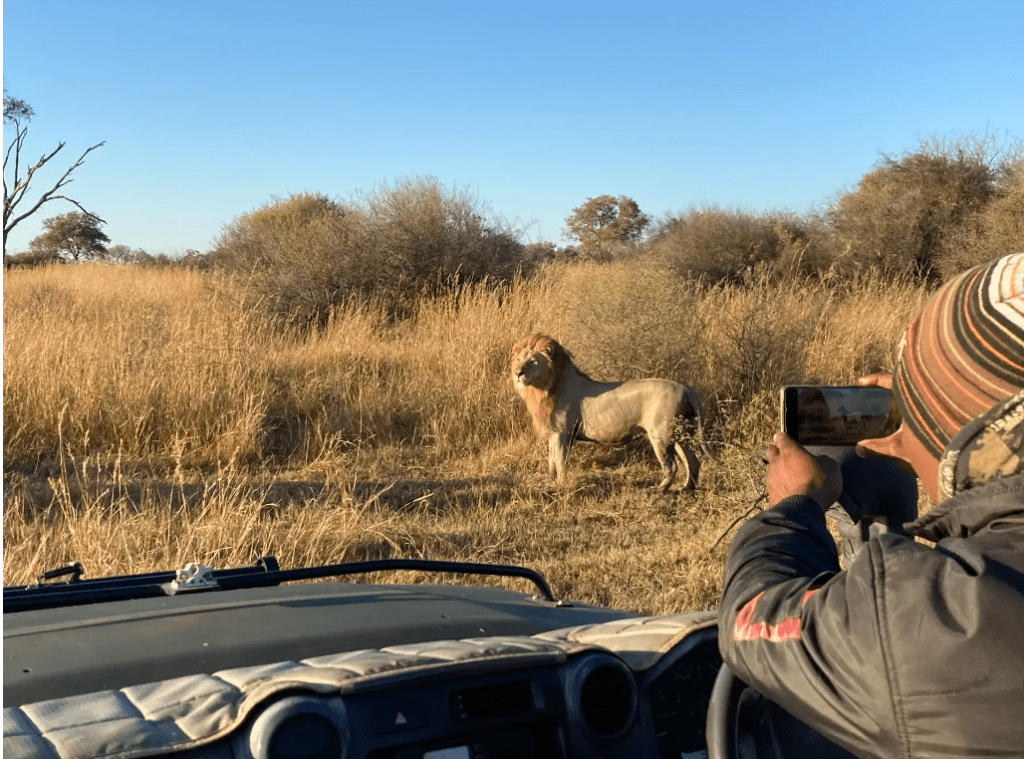
The above excitement was captured by another USA-based guest, Jon Lehman, at the same sighting on video. The lions crossing the channel and then being chased by the hippo can be viewed on our Great Plains Youtube channel here.

